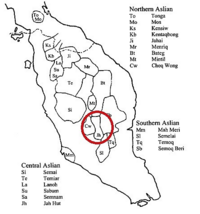Jah Hut language
| Jah Hut | |
|---|---|
| Native to | Peninsular Malaysia |
| Ethnicity | 3,760 (2008) |
|
Native speakers
|
1000-9,999 (2007) |
|
Austroasiatic
|
|
| Dialects | Kerdau, Krau, Ketiar Krau, Kuala Tembeling, Pulau Guai, Cheres, Ulu Tembeling |
| Language codes | |
| ISO 639-3 | |
| Glottolog | jahh1242 |

Distribution of Jah Hut
|
|
Jah Hut (Jah Het) is an Aslian Austroasiatic language spoken in Peninsular Malaysia. The Jah Hut people are categorised among the Orang Asli indigenous tribal peoples of Malaysia.
Jah hut is considered to be an Austroasiatic Language, existing in the Mon-Khmer branch. This can be seen through the numerous aspects of Malay that are incorporated into the language. It can be differentiated most easily however, by the lack of contrast between short and long vowels that are commonly found in other languages in the Mon-Khmer branch.
Some sources believe Jah Hut to be a sister clade to Northern and Central Aslian languages, and fall into the same phylogenetic level. However, despite this, the smaller details of Jah Hut differ significantly from many of these other languages.
Jah Hut is considered to exist as its own fourth subgroup within Senoic languages.
Dialects
Jah Hut speakers are located in Central Malaysia, and can be primarily found within the Jah Hut Tribe. The tribe is located alongside Temerloh and Jerantut. Estimates vary from 1,000 to 9,999 speakers throughout the world.
Jah Hut does not contain open major syllables in word-final positions. Conversely, the language contains 15 consonants that can be used to close a syllable. Further, in the context in which a nasalized vowel or consonant occurs earlier in a given word, the final stop is broken down into a nasal and glottal stop.
Does not contain restrictions on non-homorganic stop clusters. Meaning that many words begin with consonants that don’t phonetically match. (i.e. words that begin with ‘tk’ or ‘bk’). This pattern can be found in many other Aslian languages.
Jah Hut varies from other Mon-Khmer languages in that it contains little-to-no phonetic vowel length. It also uses Causative prefixes that are composed by p- or –r-. By using this, the speaker is able to indicate that a specific something or someone causes something or someone to be or do something else.
...
Wikipedia
